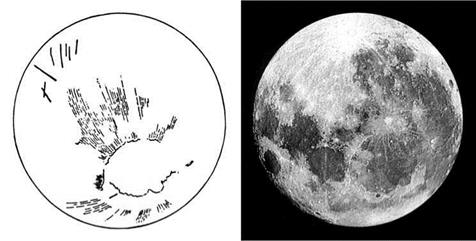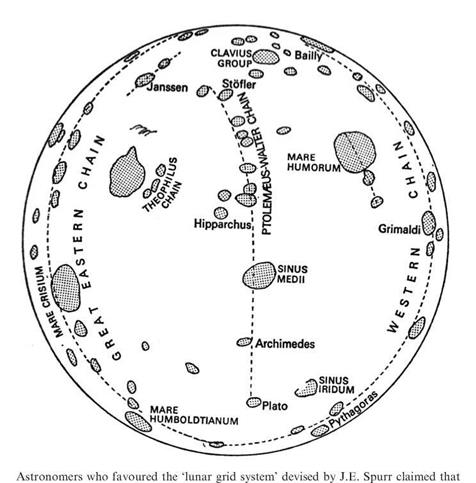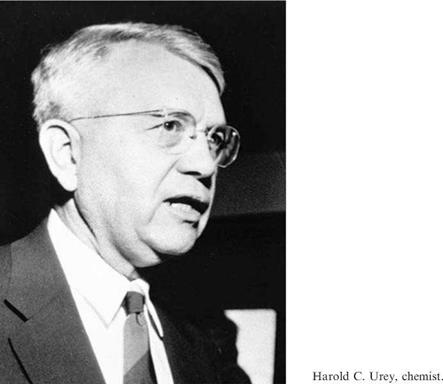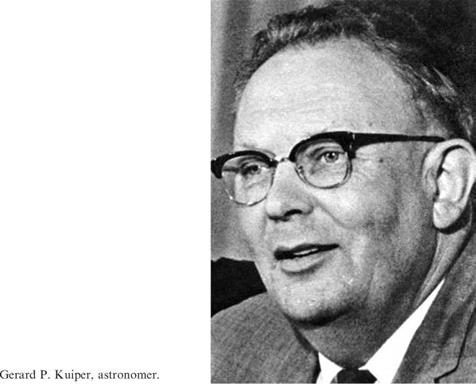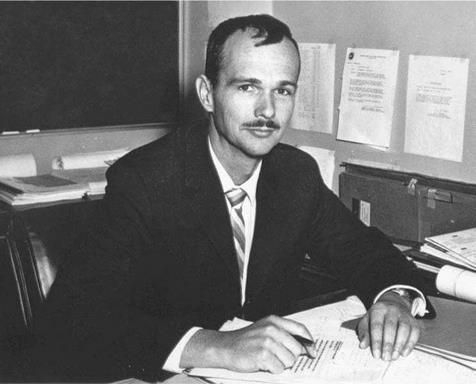A DIFFERENT POINT OF VIEW
Grove Karl Gilbert was born in Rochester, New York, in 1843. After conducting a number of surveys as a field geologist, he was made Senior Geologist when the US Geological Survey was founded in 1879. Over 18 nights during August, September and October 1892, Gilbert used the 26-inch refractor of the US Naval Observatory in Washington DC to study the Moon. Pointing out that lunar craters have floors lying generally below rather than above the level of the adjacent terrain, he rejected the
|
In 1892 Grove Karl Gilbert drew attention to ‘sculpture’ radial to Imbrium. |
volcanic interpretation and argued that craters must be the result of impacts. He further proposed that the arcuate chains of mountains at the periphery of the ‘circular maria’ are the walls of craters produced by vast impacts. As evidence, Gilbert cited what he called ‘sculpture’ as the fall of ejecta thrown out during the formation of Imbrium. He announced his results in The Moon’s Face: A Study of its Origin and its Surface Features, a paper presented orally to the Philosophical Society of Washington on 10 December to mark his retirement as its president. The paper was published in the Bulletin in 1893, but as this was not a publication on the reading list of astronomers his remarkable intrusion into their bailiwick passed unnoticed.
In 1946 Harvard geologist R. A. Daly rejected the endogenic origin of craters and, argued in favour of impact, citing Gilbert’s paper. Also in 1946, geologist R. S. Dietz expanded on the subject, listing several criteria that showed how lunar craters differ from terrestrial volcanic craters.
The American geologist J. E. Spurr began to study the Moon in 1937, having been inspired by the photographs taken by Francis Pease using the 100-inch telescope on Mount Wilson. He presumed that the Moon could be described in terrestrial terms, and between 1944 and 1949 wrote up his systematic analysis in four volumes under the general title Geology Applied to Selenology, offering volcanic explanations for a wide variety of lunar features. In particular, he said that early in lunar history large calderas left cavities which were later flooded by lava to make the ‘irregular maria’, and subsequently the better preserved ‘circular maria’. Critics of the impact origin of craters pointed out that whilst there were many examples of small craters on the rims of larger ones, there were no cases of large craters overlapping smaller ones. Spurr said craters were volcanic, and were produced with progressively smaller diameters. He interpreted faults and ridges as evidence of lines of weakness in the crust. Since he mapped these up the meridian and around the limb regions, he said they were due to stresses imparted as the Moon’s rotation synchronised with its orbital period. He
|
lines of weakness in the lunar crust, particularly up the meridian and around the limb regions, had prompted eruptions which made ‘chains’ of large craters whose members were isolated from one other by significant distances. (Courtesy Patrick Moore, Survey of the Moon, 1963) |
claimed this ‘lunar grid system’ had significantly controlled the formation of craters. This thesis was eagerly accepted by those who believed volcanism played the main role in shaping the lunar surface. In particular, it was claimed that lines of weakness had prompted eruptions that produced ‘chains’ of large craters whose members were isolated from one other by significant distances. But critics argued that the lines of weakness were illusory, since relief highlighted by the sunrise or sunset terminator will favour north-south trends and not east-west trends. And, of course, any pair of craters can be said to be related if an observer is so inclined.
It was not until Ralph B. Baldwin made an analysis of bomb craters in the Second World War that the impact origin of lunar craters began to make real headway. As a businessman trained in physics, he developed an interest in the Moon in 1941 during a visit to a planetarium when, in viewing the pictures on display, he independently noticed Imbrium sculpture. On later reading up and finding no explanation (since he did not happen across Gilbert’s paper) Baldwin decided to conduct his own study. In an article published in the magazine Popular Astronomy in 1942 he argued that the ridges and grooves were “caused by material ejected radially from the point of explosion’’ by the impact which formed Imbrium – although, like everyone else, he presumed that the impact formed the mare itself. In a follow-up in 1943 he reasoned that the projectile had been “flattened” by the shock and had excavated the cavity in a lateral manner, which was why the nearest sculpture consisted of grooves rather than chains of craters made by plunging debris – the latter occurred further out. He published in a popular outlet because his work was rejected by professional journals – evidently the Moon was not an object for worthwhile study. In his book The Face of the Moon, published in 1949 by the University of Chicago, Baldwin reported his observations, experiments and analyses, and included a review of the literature (by now he knew of Gilbert). His own contribution as a physicist drew upon an analysis of bomb craters in which he showed that the greater the deceleration on impact, the greater the energy released. He reasoned that although the weak lunar gravity would enable an explosion to throw ejecta to a greater distance, it would not actually make the crater larger. He logarithmically plotted the relationship between the diameters and depths of explosive craters on Earth, the craters on Earth accepted to have been made by cosmic impacts, and ‘fresh-looking’ lunar craters (those which had not yet slumped and distorted the ratio that he utilised). He compiled 300 measurements of lunar craters from the literature, and measured several dozen others himself. There was a clear trend.
Significantly, Baldwin realised that although most sculpture could be attributed to Imbrium, there was some which seemed to be associated with other ‘circular maria’, from which he concluded that they resulted from individual impacts. Furthermore, the mountains peripheral to Serenitatis must have formed prior to the impact that etched the Haemus with Imbrium sculpture, yet before lava flooded the Serenitatis cavity. This established that Mare Serenitatis formed a significant interval after the impact had excavated the cavity in which it resides. Baldwin (as had Gilbert) believed all the maria to have been formed at the same time and to be associated with Imbrium, which at that time was presumed to have been the greatest impact in lunar history. However, whereas Gilbert envisaged the Imbrium impact splashing out liquid ejecta which pooled in low-lying areas to form the various maria, Baldwin saw there had been a significant interval between the formation of the Imbrium cavity and its being filled in. He proposed that the impact raised a vast dome which remained inflated for long enough to be cratered (for example by Archimedes), then collapsed (forming a system of peripheral arcuate faults) and released a pulse of extremely low viscosity lava that not only filled in the cavity but also burst through the containing walls to spread across the surface and fill in other cavities to create the maria. Irrespective of whether the maria were liquid ejecta or erupted lava, it was evident that the large circular cavities were made by individual impacts over a period of time and that there was a significant interval before the formation of the maria.
|
|
Astronomers were not impressed by Baldwin’s arguments, however, and for many years continued to associate the maria with the cavities they occupied.
After reading Baldwin’s book, Harold C. Urey developed an interest in the Moon. But Urey was not particularly interested in the surface features – as a chemist at the University of Chicago who gained the 1934 Nobel Prize for chemistry, he was more interested in the Moon’s composition. He accepted that the craters were impacts and the maria were the by-product of a giant impact, but rejected Baldwin’s inference of a significant interval between the Imbrium impact and the formation of the maria. Urey agreed with Gilbert that the maria were splashes of impact melt, and said that because they were molten they could not have preserved sculpture. He also made the remarkable suggestion that the semicircular Sinus Iridum on the northern margin of Mare Imbrium marked the ‘entry hole’ of the asteroidal body whose impact created the Imbrium cavity.
In 1943 Gerard P. Kuiper began to exploit recent technical developments to make observations of bodies in the solar system. He essentially had the field to himself, at least in professional circles, and was able to make a series of discoveries. In 1953 he turned his attention to the Moon. Although photography was the norm, he mounted a binocular eye-piece on the 82-inch reflector of the McDonald Observatory in Texas to exploit moments of exceptional ‘seeing’ to discern details of the lunar surface that
|
|
would have been blurred in photographs. In his first paper on the subject, in 1954, he argued that in the case of a body of the Moon’s size, radiogenic heating would have caused sufficient melting for dense minerals to sink to create a core and lightweight minerals to rise to form a crust. This thermal differentiation would become known as the ‘hot Moon’ hypothesis. As volcanism is a means of enabling heat to escape from the interior, Kuiper argued that the maria were formed by lava upwelling at various times from deep fractures in the floors of the cavities excavated by major impacts.
In 1891, while studying the desert between Flagstaff and Winslow in Arizona in which the Canyon Diablo meteorites had been recovered, G. K. Gilbert inspected the circular hole known as Coon Butte. It was 1.2 km in diameter, had a rim which rose 45 metres above its surroundings, and a floor lying 200 metres below the rim. If it marked the site of an impact, then, he reasoned, there might be a large iron meteorite beneath its floor. A buried iron mass should be detectable by its magnetic signature, but there was no such indication. He concluded that the hole was a marr, made some 50,000 years ago when magma caused underground ice to flash to steam and blast a hole in the overlying rock. Nevertheless, in 1903 mining engineer D. M. Barringer began to drill in search of the meteorite, to no effect. In 1916 E. J. Opik realised that a cosmic impact was such a violent event that the projectile would be vaporised, but he published in an Estonian journal and his insight passed unnoticed. In 1924 A. C.
Gifford independently came to the same conclusion and published in a New Zealand journal that had a broader readership. Opik and Gifford both realised that highspeed impacts always create circular craters because whilst momentum is a vector, energy is not, and as the projectile hits the surface it essentially explodes, liberating energy in a symmetric manner and forming a circular crater. Furthermore, they realised, the crater is always much larger than the projectile. If Coon Butte was an impact crater, then the only relic of the projectile was the field of Canyon Diablo meteorites which littered the surrounding desert.
When Eugene M. Shoemaker joined the US Geological Survey in 1948 he already had an interest in the Moon. In 1949 he made a review of the literature and turned up both Gilbert’s paper and Baldwin’s recently released book, both of which advocated the impact hypothesis. In 1955 he studied two craters about 100 metres in diameter created by underground nuclear tests at the Nevada Test Site to investigate how such explosions shocked and dispersed rock. He was impressed by their resemblance to lunar craters. In 1957, with Gilbert’s analysis in mind, he began a study of Coon Butte. He had already done the field work for his PhD thesis on salt structures, but had never gotten around to writing it up. After hearing Shoemaker give a seminar on his study of Coon Butte, his advisor at Princeton, Harry Hess, suggested that he use that as the basis of his thesis. Shoemaker put in some more field work, wrote it up, and, despite it being rather on the short side for the purpose, submitted it in 1959. The fact that the crater was recent and in a desert environment made the manner in which it was excavated readily evident. In particular, the strike had not just penetrated the surface and pushed the rock aside, as Gilbert imagined; the process, as Opik and Gifford had inferred, was explosive. Significantly, Shoemaker found that two shock waves were involved: one vaporised the projectile, and the other propagated into the ‘target rock’, compressing it so thoroughly that the rock reacted just as if an explosion had occurred beneath it. In his field work Shoemaker methodically traced how the rim and the ejecta blanket formed by the stratigraphy being flipped into an inverted sequence around a circular ‘hinge’, in the process making a hole much wider than the projectile.[5]
Early in 1960 L. R. Stieff of the US Geological Survey in Washington DC set out to obtain NASA funding for an investigation of lunar geology. NASA deliberated. In 1953 Loring Coes had produced a new very dense mineral using a hydraulic press to squeeze quartz. This ‘shocked quartz’ was named coesite. In 1956 H. H. Nininger had suggested searching for coesite at Coon Butte, but this was not done. In 1960 Stieff obtained samples of rock taken from Coon Butte which were in the archive of the Smithsonian Institution in Washington DC to enable him to say to NASA that the Survey was already at work on craters. Ed Chao identified coesite using X-ray diffraction, which proved Coon Butte to be an impact crater. A press statement was released to this effect on 20 June. When Chao wrote the scientific paper, the Survey
|
Eugene M. Shoemaker, astrogeologist. |
added Shoemaker and his assistant Beth Madsen as co-authors to imply that it had a team of specialists at work. When the paper was published in Science in July I960, Shoemaker was on his way to present a paper about Coon Butte to the Geological Congress in Copenhagen. The Rieskessel in Bavaria is a 24-km-diameter structure with the town of Nordlingen at its centre. Although widely believed to be volcanic, a study in 1904 had suggested that the circular structure might mark an impact, and its characteristics had led Baldwin to classify it as such. Shoemaker examined samples of quartz from a quarry. To his trained eye, using no more than a hand-lens, the rock showed evidence of shock. The next day he airmailed samples to Chao, who called straight back to confirm that coesite was present. In giving his paper in Copenhagen about Coon Butte, Shoemaker announced the Rieskessel finding.
With the two structures having been shown to be impacts, NASA finally released the funding to enable the Survey to undertake its lunar studies, and on 25 August the Astrogeologic Studies Group was established at the Menlo Park office, south of San Francisco, with Shoemaker in charge. A year later, in 1961, it became the Branch of Astrogeology. In March 1962 Shoemaker decided to move his team to Flagstaff. The move began in December, but some people refused to relocate and were allowed to remain at Menlo Park.











